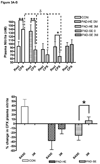Plasma nitrite flux predicts exercise performance in peripheral arterial disease after 3months of exercise training
- PMID: 20620208
- PMCID: PMC2922965
- DOI: 10.1016/j.freeradbiomed.2010.06.033
Plasma nitrite flux predicts exercise performance in peripheral arterial disease after 3months of exercise training
Abstract
Plasma nitrite is a major oxidation product of nitric oxide. It has also recently been suggested to perform an endocrine-like function as a nitric oxide donor in hypoxic tissues, allowing vasodilation. Exercise performance is limited in peripheral arterial disease because of an inadequate blood supply to working tissues. We hypothesized that exercise training in peripheral arterial disease subjects will improve "plasma nitrite flux" and endothelial function, to accompany increased exercise performance. Peripheral arterial disease subjects were tested at baseline and after 3 months supervised or home exercise training. Venous blood (arm) was drawn at rest and 10 min after a maximal graded treadmill test. Samples were added to heparin and centrifuged and plasma was snap-frozen for analysis by reductive chemiluminescence. Brachial artery endothelial function was measured in response to a hyperemic stimulus (flow-mediated dilation). At 3 months the peripheral arterial disease-supervised exercise group showed increases in claudication onset pain time (+138 s, p< or =0.05), peak walking time (+260 s, p< or =0.01), VO(2peak) (1.3 ml/kg/min, p< or =0.05), brachial artery flow-mediated dilation (+2%, p< or =0.05), and plasma nitrite flux (+33% p< or =0.05). There were no changes in the peripheral arterial disease-home exercise group. The change in plasma nitrite flux predicted the change in claudication onset pain (r(2)=0.59, p< or =0.01). These findings suggest that changes in plasma nitrite are related to endothelial function and predict exercise performance in peripheral arterial disease.
Copyright 2010 Elsevier Inc. All rights reserved.
Figures




References
-
- Rose G, Blackburn H. Cardiovascular survey methods. Vol 56. Geneva: WHO Monograph Series; 1968. - PubMed
-
- Belch JJF, Topol EJ, Agnelli G, et al. Critical Issues in Peripheral Arterial Disease Detection and Management: A Call to Action. Arch Intern Med. 2003;163(8):884–892. April 28, 2003. - PubMed
-
- Verma S, Buchanan MR, Anderson TJ. Endothelial Function Testing as a Biomarker of Vascular Disease. Circulation. 2003;108:2054–2059. - PubMed
-
- Celermajer DS, Sorensen KE, Georgakopoulos D, et al. Cigarette smoking is associated with dose-related and potentially reversable impairment of endothelium dependent dilation in healthy young adults. Circulation. 1993;88:2149–2155. - PubMed
-
- Celermajer DS, Sorensen KE, Spiegelhalter DJ, Georgapoulos D, Robinson J, Deanfield JE. Aging is assocoated with endothelial dysfunction in healthy men years before the age-related decline in women. Journal of the American College of Cardiology. 1994;24:471–476. - PubMed
Publication types
MeSH terms
Substances
Grants and funding
LinkOut - more resources
Full Text Sources
Medical

